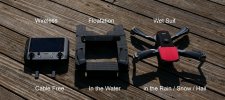- Joined
- Feb 8, 2018
- Messages
- 8,100
- Reactions
- 13,286
- Age
- 54
Calling those that live and breathe in the Ice age.
We designed a Snow / Wet Suit that has extra thermal protection designed for the Extreme Cold :
Double the thickness of a Standard Wet Suit to increase the Heat of the battery and the drone itself.
Keeps the Battery Warmer, by keeping it covered and providing an air tight seal as well as being much thicker.
Letting the camera get covered in snow , taken only 1200 ft out.
Phantomrain.org
Gear to fly your Mavic in the Rain and Snow and Land on Water.
Email me at [email protected] for more information: colors and prices.
We designed a Snow / Wet Suit that has extra thermal protection designed for the Extreme Cold :
Double the thickness of a Standard Wet Suit to increase the Heat of the battery and the drone itself.
Keeps the Battery Warmer, by keeping it covered and providing an air tight seal as well as being much thicker.
Letting the camera get covered in snow , taken only 1200 ft out.
Phantomrain.org
Gear to fly your Mavic in the Rain and Snow and Land on Water.
Email me at [email protected] for more information: colors and prices.
Last edited:












